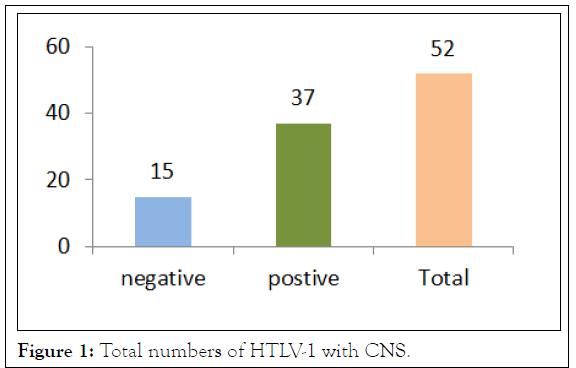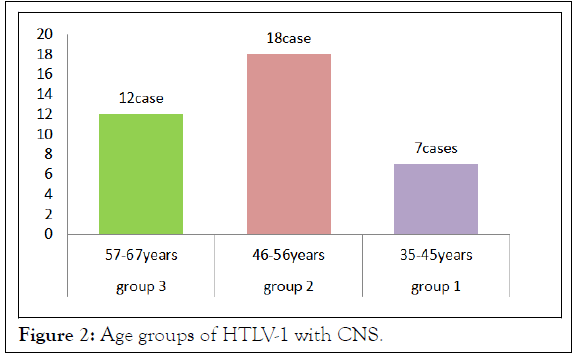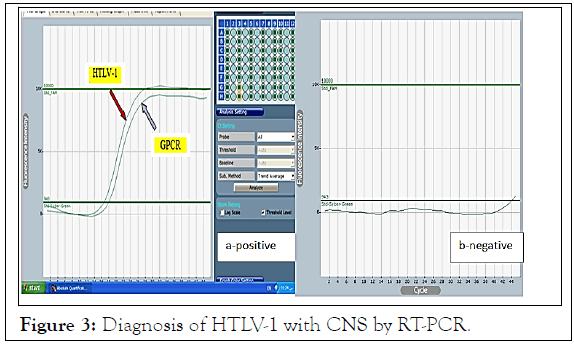Virology & Mycology
Open Access
ISSN: 2161-0517
ISSN: 2161-0517
Research Article - (2022)Volume 11, Issue 2
Human T-cell Leukemia virus type 1 was a lymphotropic retrovirus associated to Adult T cell Leukemia (ATL). RTPCR was diagnosed through primers design of G protein coupled receptors and HTLV-1 depends on the site NCBI .Three groups were divided from for both gender. Thirty seven were positive cases of human T-cell Leukemia and fifteen negative cases. Proinflammatory cytokines in the Central Nervous System (CNS) were associated with neuropathogenesis induction tumor necrosis factor alpha (TNF-alpha) and anti-inflammatory was decrease titer of IL-35. The study was conducted for the first time in Iraq and aims at diagnosing GPCR of viral infection with CNS during for 21 days and measuring the concentration of each TNF-alpha and IL-35 where the study showed significant differences of probability (p<0.05).
Leukemia; T-cell; Tumour necrosis factor; Infection
Retrovirus type C include the Human T-cell Leukemia Virus type I (HTLV-I) etiologically concomitant by Adult T-Cell Leukemia/Lymphoma (ATLL) and continuing inciting illnesses for example HTLV-I related myelopathy Tropical Spastic Paraparesis (HAM/TSP) and uveitis [1].HTLV-I mainly it affects CD4+ T-cells and several changed species of cells such as (CD8+ T-cells, B-cells, monocyte ± macrophages, endothelial cells, fibroblasts and epithelial cells). Both steward of HTLV-I comprise several classes including humans, monkeys, rabbits and rats. Conversely, the precise host ambit and cellular receptors of HTLV-I persist in a bad manner comprehend because not effective of cell-free HTLV-I to purpose to her. HTLV-I receptors instead of the glycoproteins were essential for comprehension virus-related tropism, reproduction and diseases produce infections. Newly, my diverse particles which were necessary despite HTLV-I-prompted evacuated construction be located secluded as of (MOLT-4 cell lysates) single was a trypsin susceptible thirty four up to thirty 5 kDa composite with a view to interrelates definitely using a 197 ± 216 of gp46. Syncytium creation also viral counterfeits species metrics she was comprehensively used in cellular study additionally to the molecular bases that lead to the fusion of the membrane, as well as helping to transmit the virus between two cells, as well to preventing the virus from entering it because of the encoding factors of the host. HTLV-1 infects about 5-10 million persons all over the world principally in subtropical regions. In the wide common from status, TLV-1 of human infected residue my bed wordless. Between syndrome transporters, three up to five percentages would advance of ATL otherwise the nerve infection subsequently lengthy hidden intervals forty to sixty for the age groups. The HTLV-1 genome comprises necessary restriction enzymes and structural communal via wholly retroviral familial individual. Equally a delta retrovirus, HTLV-1 likewise converts a chain from appendix in addition supervisory matrix.
Type 1 of T-cell leukemia virus was a retroviral so human infected disturb the T-cells. While considered mostly reasons not at all marks otherwise indicators, certain exaggerated individuals may subsequent progress infected virus further health environments. HTLV type one was promulgation by sharing needles, sensual exchange and blood transfusions. It is also spread through the mother to her baby during birth or natural nutrition [2,3]. Nearby was not any remediation or else therapy of virus moreover was measured a permanent stipulation, anyway, record (95%) infected people keep on without apparent symptoms during existence.
The signal is transmitted outside of a cell GPCR heterotrimeric in vivo, also stimulated eases the interchange GDP in place of GTP happening G secondary as well as consequent pointer communication to the estuary respondents. Amongst attracting white blood cells to sites of infection purpose. Now earlier ten existences, several trainings of hominoid need concentrated for both chemokines receptors four and five that entrance HIV interested in prison cell [4-6]. Consequently, using an earnings towards validate of useful importance G-protein interface. Several infections own developing plans near appropriate into cells G-protein motioning genetic material exchange complex. DNA viruses for example HSV and HIV convert GPCRs dangerous of epidemiologic reproduction also virus-relatedencouraged syndromes trendy normal congregations [7-10]. The G-Protein-Coupled Receptor (GPCR) was the major family of cell-surface receptors complicated in pointer transduction. Abnormal expression of GPCRs and G proteins were repeatedly related with prevailing human infections, comprising cancer. In datum, GPCRs be the helpful aims of more than a square of the medical drugs now on the market.
Samples collection
It was collected 52 samples of Human T-cell Leukemia virus type 1 from different for neuropathogenesis patient’s age groups ranging between 35-67 years.
Real time PCR technique
Diagnosis of Human T-cell Leukemia virus type 1 by RT-PCR, Where primers were designed in Table 1 by NCBI of HTCLV and GPRC. RNA extraction viral RNA was extracted by kit (E.Z.N.A.® Viral RNA SKU: R6874-01, Omega Bio-tek, Inc.) [11,12].
| Type primers | Name | Sequences | Bases | PCR product size |
|---|---|---|---|---|
| GPCR | Primer_4_F | TTGCTCGTCAGGACACCTTC | 20 bp | 529 bp |
| Primer_4_R | AGCTTGCCTGTGTGACTCTC | 20 bp | ||
| HTLV-1 | Primer_4_F | TGGCCCTTTCAGCAGATCAG | 20 bp | 536 bp |
| Primer_4_R | GCTGGCACGATCGATACAGA | 20 bp |
Table 1: Prepared primers of GPCR and Human T-cell Leukemia virus type 1 depended to NCBI.
Cytokine study
Detection of TNF-alpha and IL-35: Tumor necrosis factor alpha and interleukin-35 of human stayed identified by ELISA (ab181421-Human TNF alpha ELISA, CSB-E13126h-Human Interleukin 35 ELISA).
Diagnosis viruses
Thirty-seven positive samples were diagnosed (RT-PCR), and fifteen negative samples were reported as shown in Figure 1, the age group (46-56) years recorded the highest cases of infection with the virus and the number of cases was eight while the age group (35-45) years and (57-67) years were respectively, as shown in Figure 2. Combined results for HTLV-1 with CNS by RT-PCR are being displayed in Figure 3.

Figure 1: Total numbers of HTLV-1 with CNS.

Figure 2: Age groups of HTLV-1 with CNS.

Figure 3: Diagnosis of HTLV-1 with CNS by RT-PCR.
Evaluation cytokines of human
The result of two cytokines including Pro-inflammatory TNFalpha was show high titer from seven day of human infected (1.77 ± 0.23) with camper of Anti-inflammatory was(0.36 ± 0.16) also 14-21 days too, while healthy human (0.86 ± 0.19) during infected time of Human T-cell Leukemia virus type 1 was associated with neuropathogenesis, after 14 day also high titer in Table 2.
| Cytokines | Groups and number | 7 days | 14 days | 21 days |
|---|---|---|---|---|
| Pro-inflammatory TNF-alpha | Infected (n=37) | 1.77 ± 0.23 | 1.64 ± 0.26 | 1.52 ± 0.28 |
| Anti-inflammatory IL-35 | Infected (n=37) | 0.36 ± 0.16 | 0.29 ± 0.25 | 0.26 ± 0.27 |
| Control | Healthy human (n=15) | 0.86 ± 0.19 | 0. 86 ± 0.19 | 0.86 ± 0.19 |
Table 2: Results of Pro and Anti-inflammatory of Human T-cell Leukemia virus type 1.
Arithmetical examination
Consequences were articulated by way of resources ± typical mistakes for average in addition valuable alterations among collections remained defined through SPSS version 19.
The study showed that there is a relationship between viral infection and patients with the nervous system and this corresponds to the study of each in terms of the diagnostic method; note that Primers was designed based on the location of (NCBI) diagnosis of the virus, as well as the virus as shown in the Table 1. Cytokine including pro and anti-inflammatory were evaluated during 7-21 days of the infected. This corresponds to the study of TNF-α and IL-1β.
In this research, we have discussed the potential role of chemokines and their receptors in the outcome of HTLV-1 associated diseases. A great number of chemokines and their respective receptors have been implicated in the migration of HTLV-1 infected cells into CNS and skin lesions are a vital aspect in pathogenesis of HTLV-1-associated disease. Elevation of chemokines levels in serum and CSF in HTLV-1 infection has been considered as prognostic biomarkers and a promising surrogate marker for HAM/TSP treatment. The complexity of the chemokine network is perplexing. Thus, further investigation is required to target chemokine network that could open up a new door to therapy and prophylaxis against HAM/TSP and ATL.
Citation: Alameedy FMM (2022) Detection G Protein Coupled Receptors of Human T-cell Leukemia Virus Type 1 and Cytokines Study. Virol Mycol. 11:228.
Received: 09-Mar-2022, Manuscript No. VMID-22-17010; Editor assigned: 14-Mar-2022, Pre QC No. VMID-22-17010 (PQ); Reviewed: 28-Mar-2022, QC No. VMID-22-17010; Revised: 04-Apr-2022, Manuscript No. VMID-22-17010 (R); Published: 11-Apr-2022 , DOI: 10.35248/2161-0517.22.11.228
Copyright: © 2022 Alameedy FMM. This is an open-access article distributed under the terms of the Creative Commons Attribution License, which permits unrestricted use, distribution, and reproduction in any medium, provided the original author and source are credited.